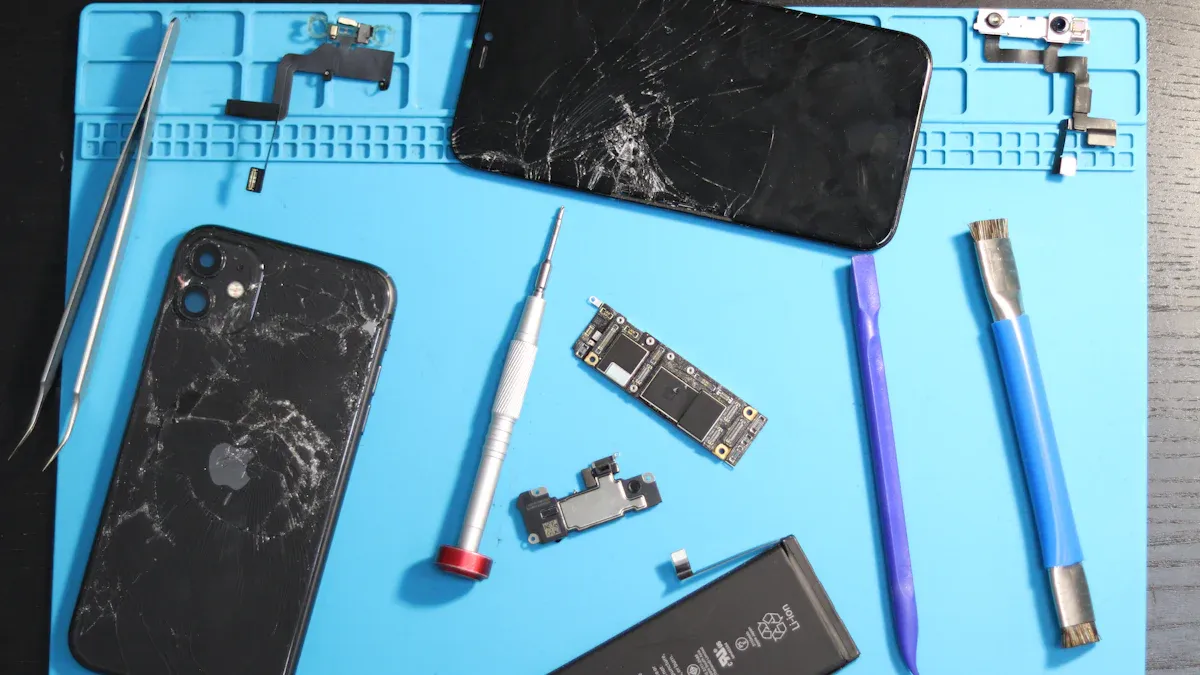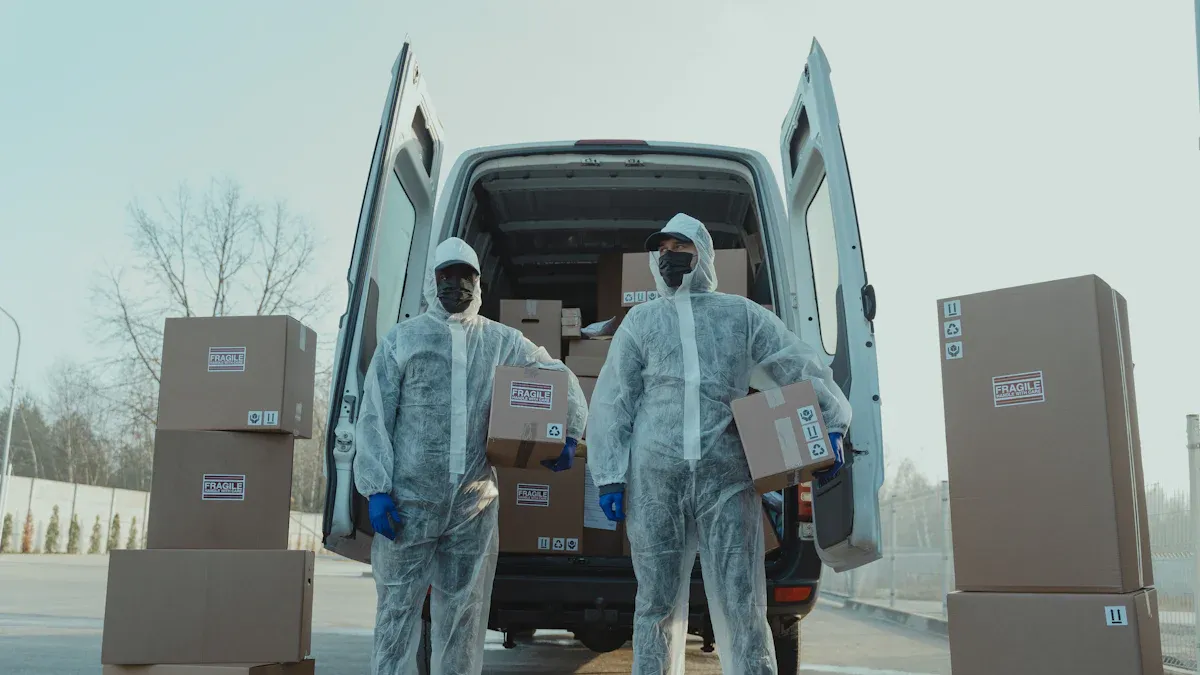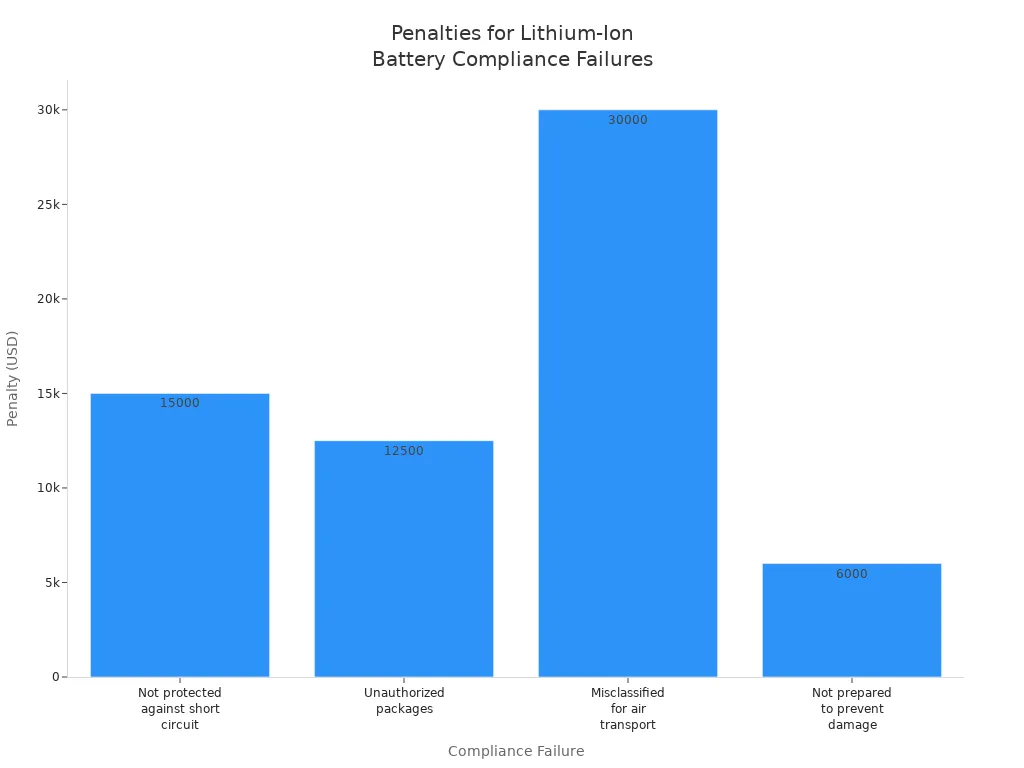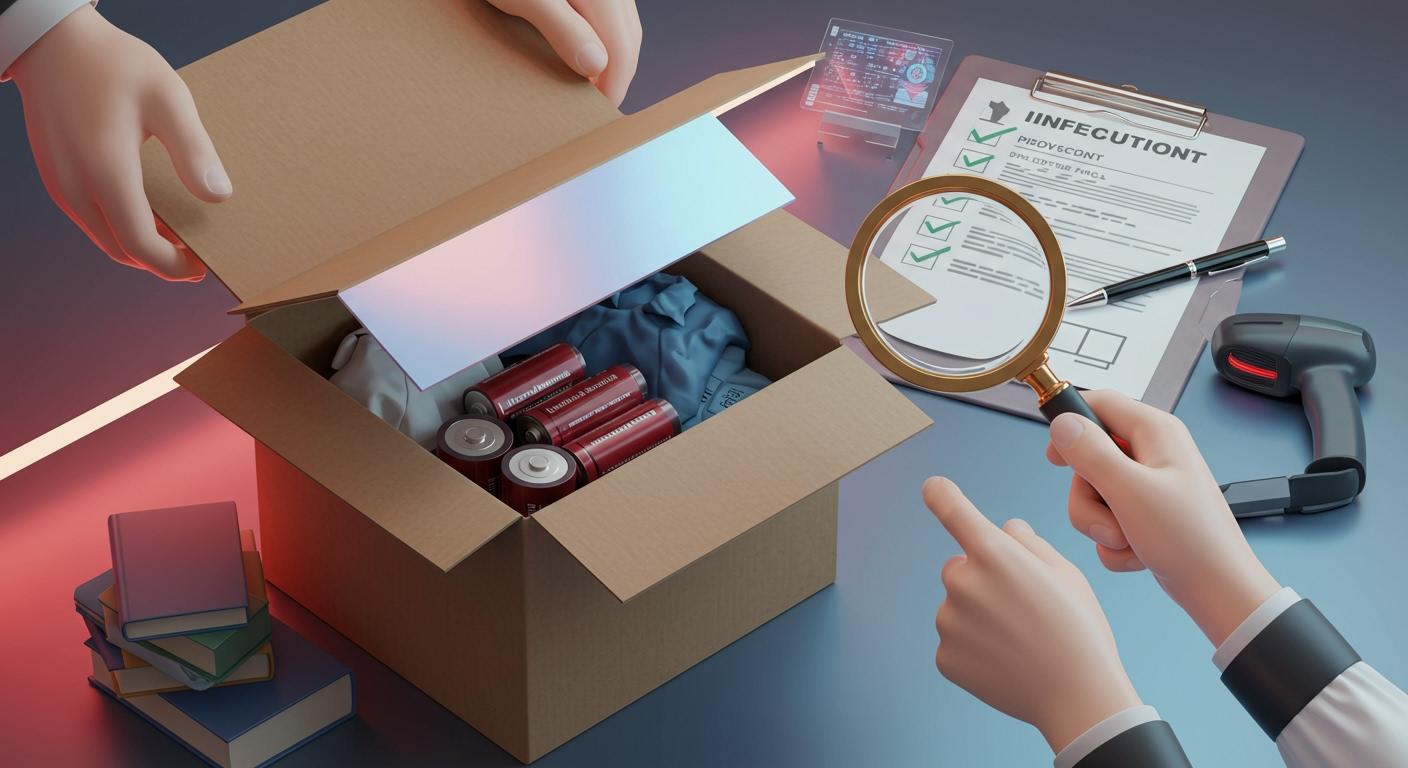Crack Down on Hidden Lithium ion Battery Shipments
You might not realize how serious the risks from hidden lithium ion battery shipments are. In recent months, the FAA issued hefty fines to companies that failed to declare or properly package lithium-ion batteries. For example:
| Company | Violation | Fine Amount | Incident Details |
|---|---|---|---|
| Mobile Sentrix | Undeclared, improperly packaged lithium-ion batteries | $170,000 | Small fire; batteries melted together during FedEx shipment |
| Mokwheel Bikes | Undeclared hazardous shipment; lack of training | $74,250 | UPS discovered shipment en route to China; safety protocols ignored |
| LG Energy Solution | Failure to declare and label package | $60,000 | Shipment emitted heat, smoke, flames at FedEx sorting facility |
These incidents show why you need to crack down on shipments that hide battery hazards. Strong compliance helps prevent fires and keeps everyone safe.
Key Takeaways
- Undeclared lithium-ion batteries pose serious fire risks during transport. Always declare and package them properly to prevent accidents.
- Regulators like the FAA enforce strict penalties for non-compliance. Companies can face fines up to $186,610 for serious violations.
- Stay informed about shipping regulations. Follow IATA and FAA guidelines to ensure safe handling and avoid costly mistakes.
- Regular training is essential for staff. Proper training reduces risks and helps maintain compliance with evolving regulations.
- Use strong packaging and limit battery charge to 30% for air shipments. This practice enhances safety and minimizes fire hazards.
Why Crack Down on Shipments
Enforcement Actions
You see more agencies taking action to crack down on shipments that hide or mislabel lithium-ion batteries. The FAA and other regulators have made the shipment of lithium-ion batteries by air a top priority. They do this because of the serious risks involved. Fires caused by undeclared lithium batteries can threaten lives and damage property. Regulators have responded with strict penalties and increased oversight.
Note: The risk of fires during transport is a major concern. Improper declaration of shipments puts everyone in danger.
Here are some recent enforcement actions:
| Year | Company/Entity | Penalty Amount | Violation Description |
|---|---|---|---|
| 2020 | U.S. e-commerce sellers | $1,100,000 | Undeclared lithium shipments |
| 2018 | Hong Kong company | $160,500 | Shipping lithium-ion batteries undeclared |
| 2023 | Mobile Sentrix (VA) | $170,000 | Undeclared mobile phone batteries, fire event |
| 2023 | Mokwheel Bikes (CA) | $74,250 | Attempted undeclared battery shipment via UPS |
| 2023 | LG Energy Solution | $60,000 | Package of lithium-ion batteries caught fire |
The total value of fines for undeclared lithium batteries in the last three years reached $304,250. These numbers show that regulators will not ignore violations. The FAA has even proposed a civil penalty of $170,000 for a single violation, showing a strong commitment to safety.
You also see calls for stricter penalties on counterfeit or mislabeled lithium-ion battery shipments. Many experts believe that only tough enforcement will stop unsafe practices. Regulators want to send a clear message: undeclared lithium batteries are unacceptable and endanger lives.
Industry and Government Response
Industry groups and government agencies have stepped up their efforts to crack down on shipments that do not follow the rules. They have introduced new standards and procedures to address the dangers of lithium-ion batteries.
- Agencies have developed performance-based standards for lithium-ion batteries.
- They have updated transport regulations to address thermal runaway risks.
- Many companies now use ventilation and cooling systems to manage battery heat.
- Emergency response training has become a key part of safety programs.
- Cargo screening, inspections, and vanning surveys help catch hidden batteries.
- Factory audits and supply chain checks increase transparency.
Chris Andrews, Director of Aviva Risk Management Solutions, stresses the need for strong precautions. He recommends safe charging, regular inspections, and employee training to reduce risks.
A recent survey by Aviva found that over half of businesses had experienced incidents involving lithium-ion batteries. About 19% reported fires or explosions. These numbers highlight why you must crack down on shipments that hide battery hazards.
You play a role in this effort. When you follow safety measures and declare lithium-ion batteries properly, you help protect everyone. The industry and government will continue to raise standards and enforce rules. You can expect even tighter compliance requirements as more incidents come to light.
Risks of Undeclared Lithium Batteries

Fire Hazards
You face serious risks when lithium-ion batteries are shipped without proper declaration. The main danger comes from fire. Lithium-ion batteries can ignite and cause Class A fires, which involve ordinary materials like wood and paper. These fires can spread quickly through cargo. Most incidents happen when batteries are hidden inside equipment and not declared. You should know that current fire suppression systems cannot stop the temperature rise in lithium cells. This leads to a thermal runaway event, where the heat keeps increasing and the fire spreads throughout the aircraft.
Here is a summary of documented fire risks:
| Fire Risk Description | Details |
|---|---|
| Class A Fires | Lithium-ion batteries can ignite surrounding cargo, leading to Class A fires involving ordinary combustibles like wood and paper. |
| Undeclared Shipments | Most incidents involve undeclared shipments of lithium batteries contained in equipment, which can result in Class A fires. |
| Thermal Runaway Risk | Current fire suppression systems cannot prevent the temperature rise in lithium cells, leading to thermal runaway and potential spread of fire throughout the aircraft. |
You must understand that the risk of a runaway fire is real. When batteries are not declared, you lose the chance to use proper packaging and safety measures. This increases the risk for everyone involved in air transport.
Airline and Traveler Impact
Undeclared lithium-ion batteries have a big impact on airlines and travelers. You see more incidents every year. In 2023, airlines reported 188 cases of overheating, smoke, fire, or explosions linked to lithium batteries. About 90% of thermal runaway incidents came from undeclared batteries. Many of these batteries did not meet IATA regulations, so they missed important safety tests and packaging.
- The FAA now requires you to keep devices with lithium batteries in carry-on baggage to lower the fire risk.
- Since March 2006, nearly 700 incidents have happened on flights, with 89 last year and 62 so far this year.
- Surveys show that 38% of travelers pack lithium batteries in checked luggage, which increases the risk of fire in the cargo hold.
- Airport signs about batteries often confuse travelers. You may not understand technical details, so raising awareness is important.
- FAA data shows lithium battery fires happen almost twice a week on U.S. flights. Flight attendants worry about these risks, with 87% expressing concern.
You help reduce risk by following airline rules and staying informed. When you declare batteries and pack them safely, you protect yourself and others from fire hazards.
Regulations and Compliance

Current Rules
You need to understand the strict regulations that control how you ship lithium-ion batteries. The International Air Transport Association (IATA) and the Federal Aviation Administration (FAA) set the main rules. The IATA Dangerous Goods Regulations guide airlines and shippers worldwide. U.S. rules, including DOT and EPA regulations, align with these international standards but sometimes add extra steps.
Here is what you must follow when shipping lithium-ion batteries:
- Standalone lithium-ion batteries cannot travel as cargo on passenger planes.
- Every package with standalone lithium-ion batteries counts as a fully regulated shipment.
- You must keep the state of charge at 30% or less for air shipments.
- Only one package of standalone lithium-ion batteries can go in each consignment.
- You need special packaging and labels, such as the lithium battery mark, Cargo Aircraft Only label, and a Dangerous Goods Declaration.
- International rules require specific packaging and labeling, and some batteries are forbidden on passenger aircraft.
You see these expanded lithium battery restrictions because lithium-ion batteries are hazardous materials. These rules help prevent fires and protect everyone involved in air transport.
Upcoming Changes
You should stay alert for new regulations that will affect lithium-ion battery shipments soon. Regulators plan to tighten rules to address new risks and technologies. The table below shows some important changes coming in the next two years:
| Effective Date | Regulation | Details |
|---|---|---|
| January 1, 2026 | State of Charge (SoC) Requirements | - Vehicles with batteries >100 Wh: Max 30% of rated capacity (mandatory) - Vehicles with batteries ≤100 Wh: Max 30% of rated capacity (recommended) - Lithium-ion batteries packed with equipment > 2.7Wh: Max 30% of rated capacity (mandatory) - Lithium-ion batteries contained in equipment: Max 30% of rated capacity (recommended) |
| 2025 | New UN Classifications | - UN 3551: Sodium-ion batteries - UN 3552: Sodium-ion batteries packed with/contained in equipment - UN 3556: Vehicle, lithium-ion-battery-powered - UN 3557: Vehicle, lithium-metal-battery-powered - UN 3558: Vehicle, sodium-ion-battery-powered |
Geopolitical tensions also shape regulatory scrutiny. For example, the EU now requires carbon footprint declarations and recycling rates for batteries. The U.S. Inflation Reduction Act encourages domestic battery production, which changes sourcing strategies. Trade disputes, especially between the U.S. and China, can disrupt the supply of lithium-ion batteries and raise costs for electric vehicles.
Tip: You should review the latest IATA Dangerous Goods Regulations and stay updated on DOT and EPA regulations to maintain compliance.
How to Stay Compliant
Proper Declaration
You must declare lithium-ion batteries correctly every time you ship them. Regulators require you to complete the Shipper’s Declaration for Dangerous Goods. You need to fill out each field clearly, including shipper and consignee details, air waybill number, and the nature and quantity of dangerous goods. You must also list the number and type of packages, packing instructions, and a certification statement.
If you skip any part of this process, your shipment may be rejected or delayed. Incomplete paperwork can lead to fines or penalties. You should always include the proper shipping name and UN identification number on the battery or packaging.
The following table shows the documentation you need for shipping lithium batteries:
| Documentation Requirement | Description |
|---|---|
| Proper shipping name and identification number | Identify batteries by their proper shipping name and UN number, found on the battery or packaging. |
| Shipping papers | Include shipper and receiver information, number of packages, weight, and proper shipping name. |
| Dangerous goods declaration | Declare the shipment contains dangerous goods and provide type and quantity of lithium batteries. |
| Marking and labeling | Mark and label packages with hazard warning labels and handling instructions. |
You must also follow international standards such as IATA Dangerous Goods Regulations, IMDG Code, and DOT Hazardous Materials Regulations.
Tip: Always double-check your paperwork before shipping lithium batteries. Mistakes can cost you time and money.
You can see the most common compliance failures in the chart below.

Packaging and Training
You need to package and handle lithium-ion batteries with care. Regulators require you to use strong, impact-resistant cases for batteries up to 100 Wh. For batteries over 100 Wh, you must use UN-approved packaging that can withstand a 1.2-meter drop test. You must limit the state of charge to 30% for air transport.
Packages must have the correct hazard labels, including the Class 9 hazard label, lithium battery handling label with a contact number, and Cargo Aircraft Only label for standalone batteries. You must mark packages with UN3480 or UN3481, depending on the battery type.
The table below shows packaging standards for different transport modes:
| Mode of Transport | Class | Packing Group | Proper Shipping Name | Labels Required | Special Provisions | Packing Instructions |
|---|---|---|---|---|---|---|
| Road/Rail | 9 | II | Lithium-ion batteries, UN3480 | Class 9 hazard label | 188, 230, 310, 636 | P903, P903a, P903b |
| Sea | 9 | II | Lithium-ion batteries, UN3480 | Class 9 hazard label | 188, 230, 310 | P903 |
| Air | 9 | II | Lithium-ion batteries, UN3480 | Class 9 hazard label | A88, A99, A154, A164 | P965, P966, P967, P968, P969, P970 |
You must prevent short circuits and damage during transit. Mishandled lithium batteries can cause fires or explosions. You should use fire-resistant containers for added safety.
Note: Never ship defective batteries. Always check for damage before packing.
You need proper training to handle lithium batteries safely. Training programs teach you how to classify, pack, mark, label, and document shipments.
Here are some training options:
| Program Name | Description | Certification | Duration | Format |
|---|---|---|---|---|
| Lithium Battery Shipping Certification | Covers shipping lithium batteries by air, ocean, and ground, including packing, marking, labeling, and documentation. | IATA/IMDG/DOT | 10-12 Hours | Online |
| Lithium Batteries Training | Focuses on regulations for classification, identification, packing, marking, labeling, and documentation specific to lithium batteries. | N/A | N/A | Standalone or Supplemental |
| Shipping Lithium Batteries | Teaches classification, labeling, and packaging of medium and large batteries, including exemptions for small batteries. | N/A | N/A | Online or On-site |
You should update your training regularly. Regulations change often, and new risks appear as technology evolves.
Alert: Make training part of your compliance strategy. Well-trained staff reduce the risk of accidents and penalties.
You can follow these best practices for shipping lithium batteries:
- Use proper hazard labels and documentation.
- Package batteries to prevent short circuits and damage.
- Never ship defective batteries.
- Limit state of charge to 30% for air shipments.
- Use fire-resistant containers for extra protection.
- Stay updated on international shipping standards.
- Train staff on handling and emergency response.
You play a key role in safe handling and compliance. When you declare, package, and train correctly, you protect people and property from the dangers of mishandled lithium batteries.
You face serious consequences if you ignore lithium-ion battery shipping rules. Fines can reach up to $186,610 for violations that cause harm, and repeat offenders risk criminal prosecution.
| Violation Type | Fine Amount |
|---|---|
| First-time violation | Up to $79,976/day |
| Serious harm caused | Up to $186,610 |
| Repeat or willful violations | Criminal charges |
- Fires or explosions can endanger lives and destroy property.
- Companies have paid penalties as high as $1.1 million for non-compliance.
Stay proactive. Take regular training, follow packaging and labeling standards, and keep up with changing regulations. You help protect people and property when you follow best practices.
FAQ
What happens if you do not declare lithium-ion batteries in your shipment?
You risk heavy fines, shipment delays, or even criminal charges. Regulators may ban you from shipping. Fires or accidents can also lead to lawsuits and damage your reputation.
How do you identify if a battery is lithium-ion?
Check the battery label for "Li-ion" or "Lithium-ion." You can also look for the UN3480 or UN3481 code. If unsure, ask the manufacturer or review the product manual.
Can you ship used or damaged lithium-ion batteries?
Never ship damaged or recalled lithium-ion batteries. Used batteries must meet strict packaging and labeling rules. Always inspect batteries for swelling, leaks, or cracks before shipping.
What training do you need to ship lithium-ion batteries?
You need certified training on packing, labeling, and documenting lithium battery shipments. Many organizations offer online courses. Training helps you avoid mistakes and stay compliant with current regulations.
-

 May.2025.11.24Ternary Lithium Battery vs Lithium-ion: Complete Comparison Guide (2025 Edition)Learn More
May.2025.11.24Ternary Lithium Battery vs Lithium-ion: Complete Comparison Guide (2025 Edition)Learn More -

 May.2025.11.214S2P 18650 14.8V Battery: Complete Technical Guide, Specs, Applications & SafetyLearn More
May.2025.11.214S2P 18650 14.8V Battery: Complete Technical Guide, Specs, Applications & SafetyLearn More -

 May.2025.11.18PCM vs BMS in Lithium Batteries: What’s the Difference and Which One Do You Need?Learn More
May.2025.11.18PCM vs BMS in Lithium Batteries: What’s the Difference and Which One Do You Need?Learn More -

 May.2025.11.17Custom Li-ion Battery Design for Medical Devices (2025 Comprehensive Guide)Learn More
May.2025.11.17Custom Li-ion Battery Design for Medical Devices (2025 Comprehensive Guide)Learn More -

 May.2025.11.17The Future of Lithium-Ion Batteries: Innovation, Sustainability, and Global Market TrendsLearn More
May.2025.11.17The Future of Lithium-Ion Batteries: Innovation, Sustainability, and Global Market TrendsLearn More
















